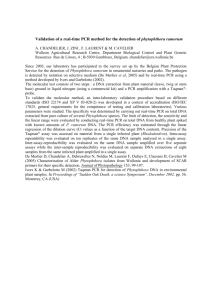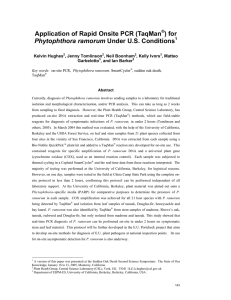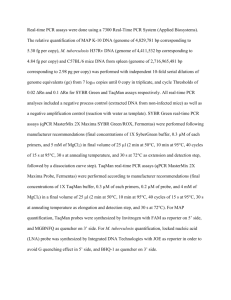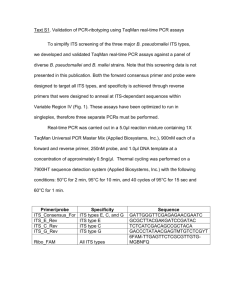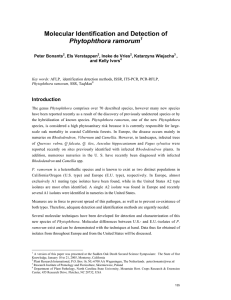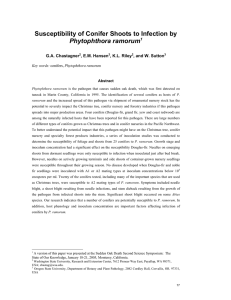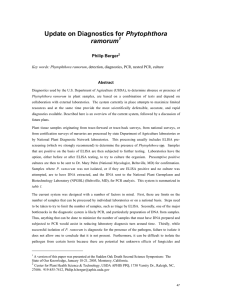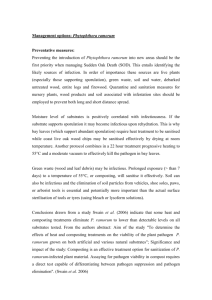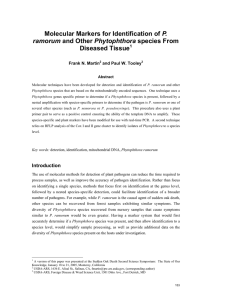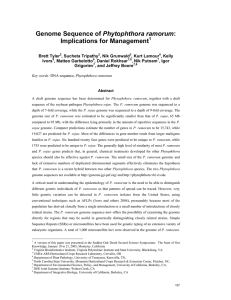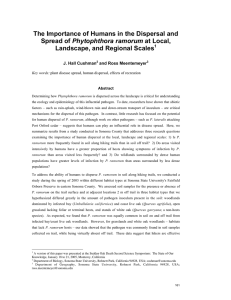Phytophthora ramorum by Real-Time PCR Using Taqman, SYBR Green
advertisement
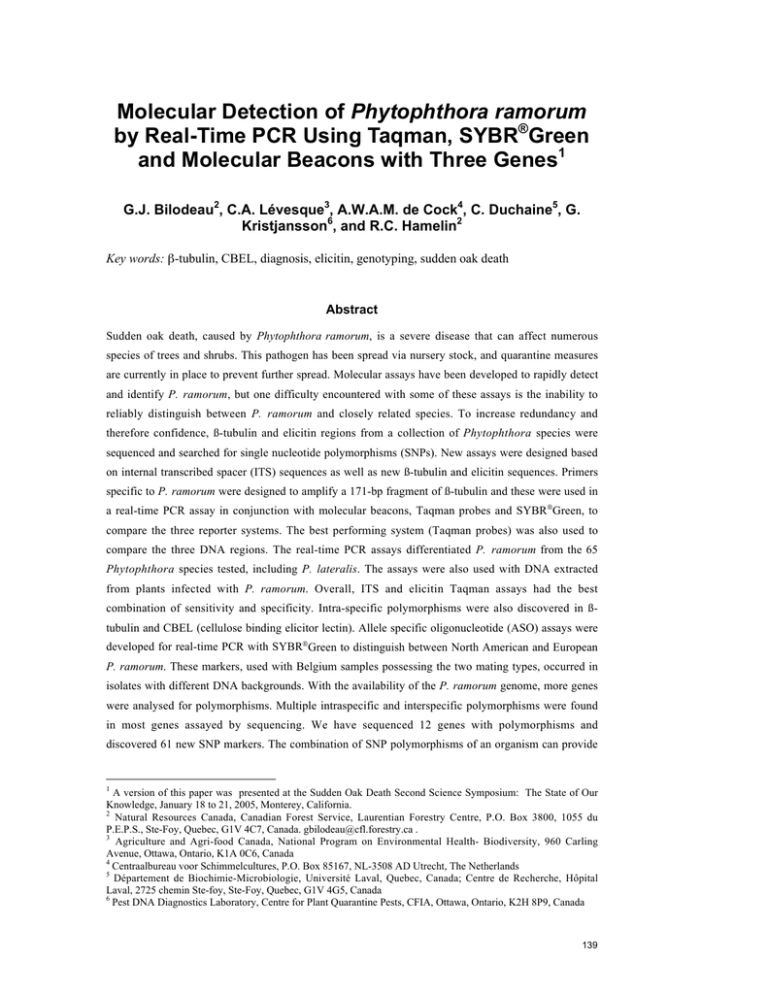
Molecular Detection of Phytophthora ramorum by Real-Time PCR Using Taqman, SYBR®Green and Molecular Beacons with Three Genes1 G.J. Bilodeau2, C.A. Lévesque3, A.W.A.M. de Cock4, C. Duchaine5, G. Kristjansson6, and R.C. Hamelin2 Key words: -tubulin, CBEL, diagnosis, elicitin, genotyping, sudden oak death Abstract Sudden oak death, caused by Phytophthora ramorum, is a severe disease that can affect numerous species of trees and shrubs. This pathogen has been spread via nursery stock, and quarantine measures are currently in place to prevent further spread. Molecular assays have been developed to rapidly detect and identify P. ramorum, but one difficulty encountered with some of these assays is the inability to reliably distinguish between P. ramorum and closely related species. To increase redundancy and therefore confidence, ß-tubulin and elicitin regions from a collection of Phytophthora species were sequenced and searched for single nucleotide polymorphisms (SNPs). New assays were designed based on internal transcribed spacer (ITS) sequences as well as new ß-tubulin and elicitin sequences. Primers specific to P. ramorum were designed to amplify a 171-bp fragment of ß-tubulin and these were used in a real-time PCR assay in conjunction with molecular beacons, Taqman probes and SYBR®Green, to compare the three reporter systems. The best performing system (Taqman probes) was also used to compare the three DNA regions. The real-time PCR assays differentiated P. ramorum from the 65 Phytophthora species tested, including P. lateralis. The assays were also used with DNA extracted from plants infected with P. ramorum. Overall, ITS and elicitin Taqman assays had the best combination of sensitivity and specificity. Intra-specific polymorphisms were also discovered in ßtubulin and CBEL (cellulose binding elicitor lectin). Allele specific oligonucleotide (ASO) assays were developed for real-time PCR with SYBR®Green to distinguish between North American and European P. ramorum. These markers, used with Belgium samples possessing the two mating types, occurred in isolates with different DNA backgrounds. With the availability of the P. ramorum genome, more genes were analysed for polymorphisms. Multiple intraspecific and interspecific polymorphisms were found in most genes assayed by sequencing. We have sequenced 12 genes with polymorphisms and discovered 61 new SNP markers. The combination of SNP polymorphisms of an organism can provide 1 A version of this paper was presented at the Sudden Oak Death Second Science Symposium: The State of Our Knowledge, January 18 to 21, 2005, Monterey, California. 2 Natural Resources Canada, Canadian Forest Service, Laurentian Forestry Centre, P.O. Box 3800, 1055 du P.E.P.S., Ste-Foy, Quebec, G1V 4C7, Canada. gbilodeau@cfl.forestry.ca . 3 Agriculture and Agri-food Canada, National Program on Environmental Health- Biodiversity, 960 Carling Avenue, Ottawa, Ontario, K1A 0C6, Canada 4 Centraalbureau voor Schimmelcultures, P.O. Box 85167, NL-3508 AD Utrecht, The Netherlands 5 Département de Biochimie-Microbiologie, Université Laval, Quebec, Canada; Centre de Recherche, Hôpital Laval, 2725 chemin Ste-foy, Ste-Foy, Quebec, G1V 4G5, Canada 6 Pest DNA Diagnostics Laboratory, Centre for Plant Quarantine Pests, CFIA, Ottawa, Ontario, K2H 8P9, Canada 139 GENERAL TECHNICAL REPORT PSW-GTR-196 a fingerprint or a biological barcode that uniquely identifies an individual. Using these 61 SNPs we found that isolates from Holland and Belgium had identical DNA profiles to samples from British Columbia (B.C.) isolated in 2003, but that profile was distinct from those found in the California isolates at all 61 SNPs. However, isolates from B.C. discovered in 2004 had a DNA profile that matched 100% with DNA profiles of the California isolates. Genotyping assays are currently being developed to allow simultaneous diagnosis at the species level, as well as for multilocus fingerprinting of individuals. This should be a useful tool in understanding the origin and migration of P. ramorum. 140


